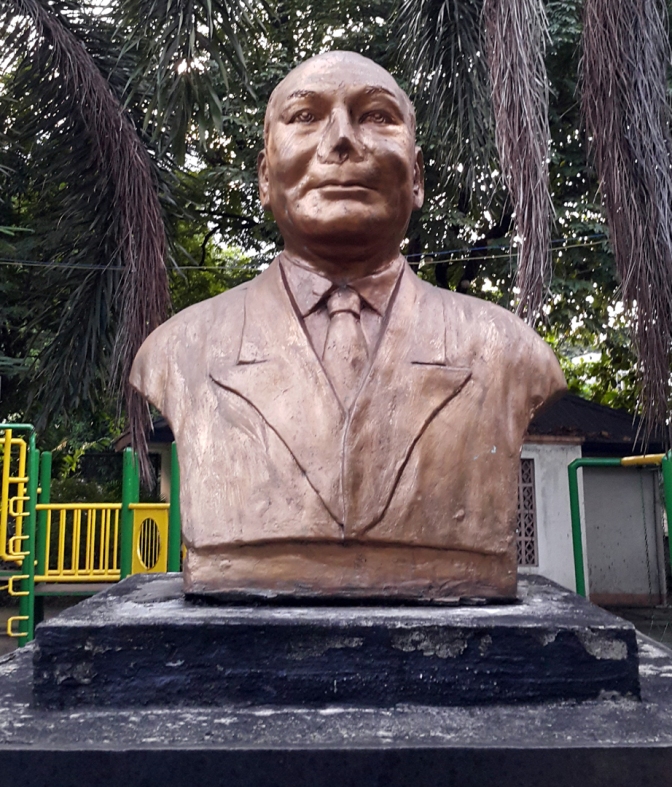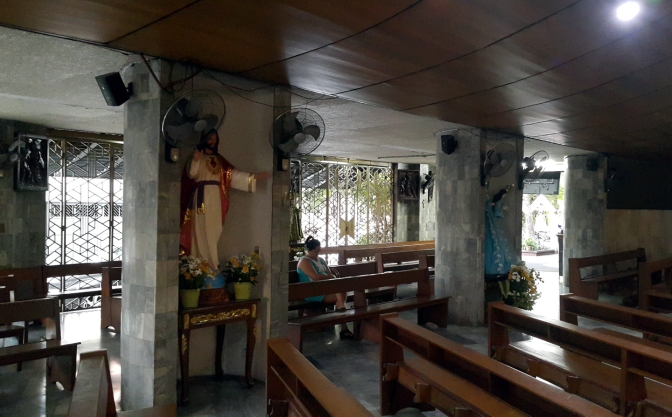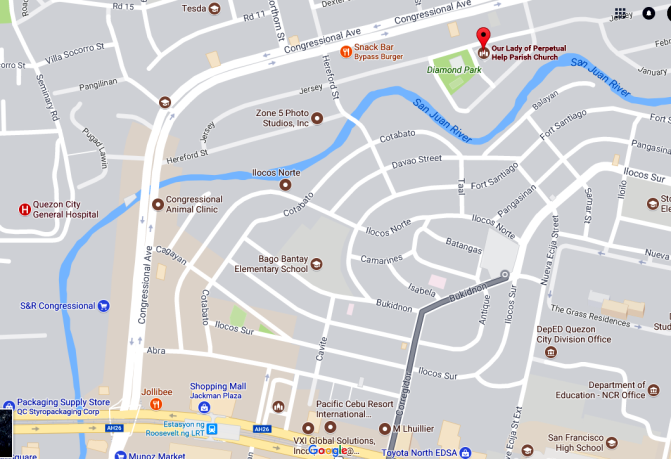The history of the Our Lady of Perpetual Help Parish, along Jersey Road, is tied to the very story of the locality of Bahay Toro, or Project 8 district of Quezon City. Before the establishment of Quezon City, the area was once called Barrio Bungad (Threshold), as it lay between the borders of the old towns of Novaliches and Balitawak. When Quezon City was founded in 1939, Bungad would become part of the first 44 barrios of the new city. In the 1960s, the city councilor Victoriano Diamonon renamed the barrio to Barangay Bahay Toro, after the Spanish Era name of the area that came from the many Carabao (water buffalo, Bubalus bubalis) grazing in the fields of the undeveloped lots. As a resident of the area, Don Diamonon was crucial to the development of the Bahay Toro, and the establishment of the modern barangay system in the Philippines. To commemorate the contributions of Don Diamonon, a park beside the Our Lady of Perpetual Help Parish was named after him in 1994, with his bust in the center.

Victoriano Dinum Diamonon (1894-1977) is a noted politician, political scientist, and sociologist of Quezon City; and who is considered the “Father of the Modern Barangay”. Orphaned at an early age, Dimonon grew up in abject poverty with his 12 other siblings, in the province of Iloilo, in the Visayas Region. After graduating high school, Diamonon left Iloilo at the age of 16, to take his undergraduate studies in Manila. He supported himself doing odd jobs, while studying, and was able to get a scholarship to the University of Iowa, where he became the first Filipino to garner a doctorate in political science, graduating with honors. During his doctoral studies, Diamonon wrote “A Study of the Philippine Government During the Spanish Regime” (1919) and “The Development of Self-Government in the Philippine Islands (1920), which was followed up with “A Political History of the Philippines” in 1930. It was in his second book that Diamonon expounded on his plans for the modern barangay system, which would be enforced during his political tenure in Quezon City, and encoded to law in 1974. Active in diplomatic affairs since the 1930s, in 1945, Diamonon was selected to be part of the first Philippine delegation to the United Nations along with Carlos Peña Romulo (1898- 1985), Raul T. Leuterio (1904-1970), Lorenzo S. Sumulong (1905-1997), and Salvador Ponce Lopez (1911-1993). After retiring from diplomatic work he was appointed as the head of the Legislative Division of Congress. In 1960, Diamonon was asked to run as a city councilor for Quezon City. Being a part of the first duly eleceted officials of the city, Diamonon served by representing the urban poor. During his service to Quezon City, Diamonon worked with Vice-Mayor/Captain Carlos Lukban Albert (1915-1975), Justice Pedro Tiangco Tuazon (1884-1961), U.P. President/Engineer Vidal A. Tan (1893-1978), Constitutionalist/Dean Conrado Francia Benitez (1889-1971), and Senator/Governor/Ambassador Proceso Esmeria Sebastian (1892-?); and were dubbed as the “Six Wise Men of Quezon City”.

The Our Lady of Perpetual Help Parish Church started, like many of the local churches, as a small chapel that was set up by the local residents, in 1958. What started as a small barrio in the 1940s, the population began to grow steadily with the influx of migrants from Manila, who were displaced after the city was heavily devastated by the bombings of World War II. The chapel was serviced by the Franciscans priests from the San Pedro Bautista Parish and the Missionary Oblates of Mary Immaculate (OMI), which was around 4 kilometers away. The chapel was initially named Chapel of Nuestra Señora Virgen del Rosario (Our Virgin Lady of the Rosary), after the 1854 church in Salinas, Cavite Province. To this day, an 1885 bell is on display at the entrance of the Our Lady of Perpetual Help Parish.

Established as a parish in 1966 with Fr. Alfonso Caparas (+1988) as its first parish priest, and the first church was a simple structure of wood and concrete, and was renamed to Our Lady of Perpetual Help Parish. The residents selected their new patron after the miraculous 15th century Byzantine icon at the Chiesa di Sant’Alfonso di Liguori all’Esquilino in Rome, to whom many Filipinos are devotees, especially at the National Shrine of Our Mother of Perpetual Help in Baclaran Parañaque City.
From its simple structure, the Our Lady of Perpetual Help Parish had undergone several renovations, since its establishment in 1966. And in 1979, the final design was unveiled. The new church was very modernist design, with a diamond or kite like floor plan and jutting nave that was meant to resemble a perched dove.
The interiors of the Our Lady of Perpetual Help Parish continue the modernist simplicity, of flowing lines that are marked with the use of dark wooden accents. At the altar, the traditional retablo (altarpiece) has been removed in place of a white marble wall that brings focus to the crucifix at the center.

Throughout out the church are hollowed half-circle shaped columns, which serve as niches of the many different saints that the parishioners wish to pray to. This compensates the lack of the retablo and its myriad of icons on display.
At the open aired side halls are the 14 Stations of the Cross, or Via Crusis. Carved out of the narra hardwood (Pterocarpus indicus), these pieces depict 14 stations of the Passion and Death of Jesus Christ, starting with his condemnation to death by Pontius Pilate and ends with his burial in the tomb. The observation of the Via Crusis is held every Lenten Season, during the Visita Iglesia (7 church pilgrimage).
At the south basement of the Our Lady of Perpetual Help Parish are the Mourning Madonna Mortuary Viewing Chapels. This used to the location of the parish offices and the Perpetual Adoration of the Blessed Sacrament Chapel, which was completed in 1986.
In 1990 the Adoration Chapel was moved to the entrance of the church, and renamed as the Perpetual Eucharistic Adoration Chapel. The chapel was renovated and opened in 2015, with new stained glass windows.

The Our Lady of Perpetual Help Parish does not have any significant collections of artworks, such as the other churches that I have written about. Neither is the name of its architect remembered. However, this church stands as a significant development in modern Philippine architecture.


























4 thoughts on “Congressional Avenue, Quezon City: Our Lady of Perpetual Help Parish Church, Jersey St. Project 8”